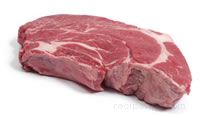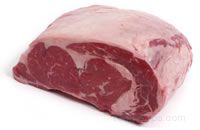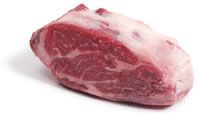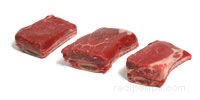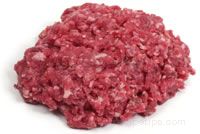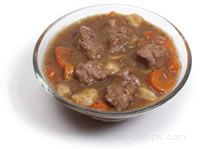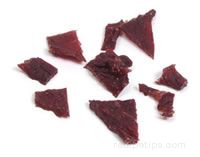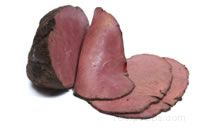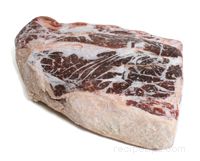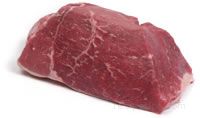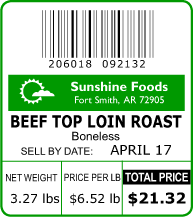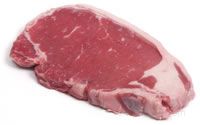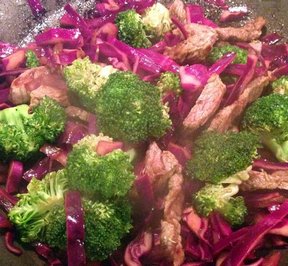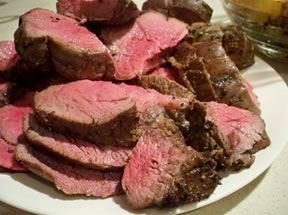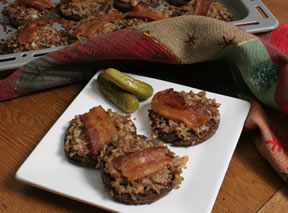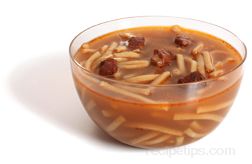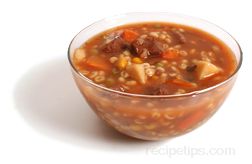Chuck | Rib | Short Loin | Sirloin | Round | Brisket
Plate | Flank | Variety Meats | Degree of Tenderness
|
Beef primal cuts are also known as wholesale cuts, because they are usually sold to meat markets where they are cut further. This next stage of cutting reduces the primal cuts into smaller beef cuts known as subprimal cuts, such as the tenderloin, which is cut from the short loin primal. These subprimal cuts can be cut even further, transformed into the roasts and steaks that consumers are accustomed to seeing in food stores and meat markets. A tenderloin subprimal cut, for example, can be cut into the smaller portions that are familiar to consumers, such as filet mignon steaks, chateaubriand steaks, tournedos, and bifteck steaks. These smaller cuts are also known as consumer cuts, retail cuts, or market ready cuts. Beef cuts may consist of a single muscle, such as the tenderloin, while others may be a cross section of several muscles. A Porterhouse steak, for example, is a cross section of parts of the top loin and tenderloin muscles. Many cross section cuts include some bone. Cuts of beef that are obtained from the center of the animal, such as the loin and rib area, are the most tender. This is because the muscles in these areas are suspension muscles and do not move as much as the muscles in the front and rear portions of the animal, which are responsible for locomotion. The more a muscle is used, the less tender it is. Various cuts of beef may differ in name between different countries and even in different regions of the same country, so it can be confusing. For example, in the United States, the rear section of the carcass is known as the round, but in Canada, the same section is called the hip. Described in the tables below are the primal cuts of beef and the sub-primal and market ready cuts obtained from them. |
Primal Cut - ChuckThe chuck primal cut extends from the neck to the fifth rib and includes the shoulder blade and upper arm. It is often divided into two main sections, or sub-primals, known as the blade portion and the arm half. The blade portion includes the following:
The arm half, located below the blade and neck portion, includes the following:
The chuck has plenty of connective tissues that melt when the meat is cooked. This helps to add flavor and also helps to tenderize the meat. Although chuck cuts are flavorful, they are not as tender as the loin and rib cuts. They can become rather tough if not cooked properly. Cuts from the chuck benefit from slow cooking using moist heat methods, such as braising. | ||
| Subprimal Cut | Market Ready Cuts | Description |
| Blade |
Chuck Eye Roast |
The chuck eye is a continuation of the rib-eye meat. It is similar to the rib-eye meat of the rib primal (ribs 6-12) except that it is located in the chuck primal (ribs 1-5). The chuck eye is also not as tender as the rib-eye meat. Alternate names for the chuck eye roast include:
|
|
Chuck Eye Steak |
The chuck eye steak is cut from the chuck eye roast. The chuck eye steak is also known as:
| |
|
Top Blade Roast |
The top blade is located above the shoulder blade and is known as the top blade roast. Other names for the top blade roast include:
| |
|
Top Blade Steak |
The top blade steak is a smaller cut from the top blade roast. It is often referred to as a Flatiron Steak. It is given this name because of the shape of the steak, which often resembles an old-fashioned flat iron. Some butchers, meat markets, and beef organizations use the names top blade steak and flatiron steak interchangeably, while others insist that one should not be confused with the other, claiming that the flatiron and an accompanying steak referred to simply as the blade steak are different (the blade steak has more gristle) but are both cut from the same muscle group. Other names given to the top blade steak or flatiron steak include:
| |
|
Mock Tender Roast |
The mock tender is a cone shaped muscle next to the top blade and is often sold as a roast. The name mock tender is misleading, because the meat actually isn't very tender. It is best when it is braised or slow cooked. Alternate names for the mock tender roast include:
| |
|
Mock Tender Steak |
The mock tender roast can also be cut into steaks, which are known by various names including:
| |
|
Under Blade Roast |
The under blade is directly below the shoulder blade and is sold as the boneless under blade roast. It is also known by the following names:
| |
| Under Blade Steak | The under blade roast can be cut further into under blade steaks. | |
| 7-Bone Roast |
The 7-bone roast is a cross cut roast of the shoulder blade. It gets its name from the cross cut of bone that is shaped like the number 7. The 7-bone roast is one of the most popular for pot-roasting or slow cooking. It is also known by the following names:
| |
| 7-Bone Steak | The 7-bone steak is cut from the 7-bone roast. | |
| Neck Pot Roast | The meat is obtained from the seven vertebrae of the neck. Stew meat is also cut from this area. | |
| Arm |
Arm Roast |
The main part of the upper arm is the location where the arm roast is obtained. The arm roast is also called:
|
| Arm Steak (Swiss Steak) |
A steak cut from the arm roast is often referred to as a Swiss steak (as is a steak from the bottom round). | |
| Boneless Shoulder Roast |
The boneless shoulder roast is also known as the English roast and is located directly behind the arm roast. | |
| Boneless Shoulder Steak | A boneless chuck shoulder steak is cut from the larger boneless chuck shoulder roast. It is usually cut no thicker than one inch, weighs ten ounces or less, and is usually trimmed of all fat. Since it is from the chuck primal, it is very flavorful, but it can be a bit tough. A center cut steak from the boneless chuck shoulder is known as a Ranch Steak. | |
| Cross-rib Roast |
A cross-rib roast contains the meaty portions on the top of ribs 3 through 5. The cross-rib roast is also known by the following names:
| |
| Short Ribs
|
Ribs 1 through 5 are located in the chuck primal. They have plenty of meat and have less fat than short ribs from the plate. Short ribs cut parallel to the bone are known as English style short ribs. They sometimes include a bit of the bone or can be sold boneless. Short ribs that are cut across the rib bones are known as flanken. | |
| Other |
Stew Meat |
Scraps of various chuck cuts can be used as stew meat. |
| Ground Chuck (Ground Beef) |
Chuck scraps can be ground, which are labeled as ground chuck or ground beef. (In order to be labeled ground beef, the product must be at least 70% lean.) | |
Primal Cut - RibThe beef carcass has thirteen pairs of ribs, but not all of the ribs are included in the rib primal cut. The first five ribs are part of the chuck cut in the front of the animal. The thirteenth rib is part of the loin. The rib primal contains ribs 6 through 12. Beef from the rib primal is often described as middle meat (as is beef from the loin). The cuts obtained from the rib primal are very tender and contain many of the best steaks and oven roasts. Rib roasts are generally taken from the area of the ninth through the twelfth rib. A short rib refers to a small piece that has been trimmed from the main portion of a rib when the rib section is trimmed into smaller cuts. Dry heat cooking methods, such as grilling, broiling, and roasting, bring out the flavor of rib cuts and keep the meat tender. | |
| Subprimal / Market Ready Cuts | Description |
| Back Ribs | Back ribs are the portion remaining after a rib roast is boned. Sometimes the ends of the ribs are cut from the full rib and are called short ribs. The ends of the sixth through the twelfth ribs are actually located in the plate primal cut. |
| Rib-Eye Roast | The rib-eye roast refers to a rib roast that has had the sixth through the twelfth rib bones removed leaving just the rib-eye muscle. It is tender, flavorful, and expensive. The rib-eye roast is also known as a Delmonico roast. |
| Rib-Eye Steak | A rib-eye steak is cut from the rib-eye roast. Other names for the rib-eye steak include:
|
| Rib Roast |
A rib roast is the same as a rib-eye roast except that the bones have not been removed. A full seven bone rib roast (ribs 6 through 12) usually weighs 16 pounds and up, so it is often cut into two sections known as the first cut rib roast and the second cut rib roast. The first cut is also called a small end rib roast and includes ribs 9 or 10 through 12, which is nearer the loin primal. The second cut, also known as the large end rib roast, includes ribs 6 through 8 or 9 and is nearer the chuck primal. A rib roast that includes the bones is also known as a standing rib roast. If the rib roast is boned, rolled, and tied, it is known as a rolled rib roast. |
| Rib Steak | A rib steak is cut from the rib roast. It is the same steak as the rib-eye, except that it contains the bone. |
Primal Cut - Short LoinThe short loin is contained within the larger cut called the loin. The loin is divided into the short loin and the sirloin. The short loin and sirloin may be considered two separate primal cuts or they may be considered parts of the whole. The short loin includes the thirteenth rib and the small of the back. The short loin is the most tender of the primal cuts, because the muscles in this area are the least used. The top loin muscle is the largest muscle, and the tenderloin is the smaller inside muscle. Cuts from the short loin are also the most expensive. They are very lean, but usually lack the flavor of some of the tougher beef cuts that contain more fat and connective tissue. Some of the best steaks are cut from the short loin including the Porterhouse and T-bone. It is best to cook beef cuts from the short loin with dry heat cooking methods, such as grilling, broiling, and roasting. It is important not to overcook loin cuts, because they can loose their natural tenderness, which is one of the primary reasons for purchasing them. | ||
| Subprimal Cut | Market Ready Cuts | Description |
| Top Loin |
The top loin is the largest muscle of the short loin. The top loin roast is cut from the top loin and it is also known by the following names:
| |
|
Boneless |
Boneless top loin steaks are cut from the top loin and are very tender and flavorful. The following are the different names given to the boneless top loin steak, depending on the part of the country in which they are sold:
| |
|
Bone-in |
Bone-in top loin steaks are cut from the top loin. Top loin steaks are tender and flavorful and are much like a Porterhouse or T-bone, but with the tenderloin portion removed. The following are the different names given to the bone-in top loin steak, depending on the part of the country in which they are sold:
| |
| Tenderloin |
Tenderloin Roast |
The tenderloin is the inside muscle of the short loin and is the most expensive cut of beef. It is a long tapered muscle extending from the thirteenth rib to the pelvis. Part of the large end, or butt end, is actually within the sirloin section. When preparing tenderloin roasts, many butchers cut off part of the butt end (sirloin end). The opposite end of the tenderloin is tapered and is known as the small end, or tail, and is often folded under the center portion of the tenderloin (known as the heart) and tied to form a roast with a consistent diameter. A tenderloin that is not trimmed of the outer fat layers may weigh as much as nine pounds. It may weigh as much as five pounds when it is trimmed. When roasted, the whole tenderloin is the most desirable beef cut in terms of tenderness. It is also known as:
|
|
Tenderloin Steaks |
The trimmed tenderloin can be cut into steaks, which in the United States are often called filet steaks or filet mignon; however, based on the location of the tenderloin in which the steaks are cut, they are more specifically known as one of the following:
In France, tenderloin steaks are often described as follows:
| |
| Crosscuts | Porterhouse Steak | The Porterhouse steak is a crosscut steak containing part of the tenderloin and part of the top loin. It is similar to a T-bone steak except that it is thicker and the proportion of the tenderloin to the top loin is greater. |
| T-bone Steak | The T-bone is another crosscut steak and is similar to the Porterhouse, but with less of the tenderloin included. | |
Primal Cut - RoundBeef cuts from the round are located in the rear portion of the carcass, which includes the top of the leg, or hind shank, and the rump. Cuts from the round primal are lean but not naturally tender. The fat and marbling present in some of the other primal beef cuts, which helps to tenderize meat as it cooks, is lacking in cuts from the round primal; therefore, a moist slow cooking method, such as braising, should be used to tenderize the meat. Oven roasting can be used only when the round cuts are of the highest quality. | ||
| Subprimal Cut | Market Ready Cuts | Description |
| Bottom Round |
The bottom round roast is the outside muscle of the upper leg. The bottom round may be used as an oven roast if it is of the best quality and it is not overcooked, but it is much better if it is braised. | |
| Bottom Round Steak (Swiss Steak) |
The bottom round steak is often referred to as a Swiss steak (as is a chuck arm steak). | |
|
Standing Rump Roast Boneless Rump Roast |
The rump roast is another beef cut that can be a bit tough, especially if it is roasted in the oven. It is much better when it is pot-roasted. A rump roast that has not been boned is known as a standing rump roast. A boneless rump roast is sometimes sold as is or it may be rolled and tied before it is packaged and sold. | |
| Eye Round | The eye round is the eye muscle of the bottom round. The eye round roast is boneless and can be a bit tough, so it is best to cook it with a moist heat process, such as braising or slow cooking. | |
| Eye Round Steak | The eye round steak is cut from the eye round roast. | |
| Top Round |
The top round is the inside muscle of the upper leg. The top round roast is obtained from the top round. | |
|
Round Steak London Broil |
The top round steak is a thick steak that is cut from the top round roast. A thinner steak cut from the top round roast is simply called a round steak. London Broil is the name sometimes given to a top round steak, but it is more often cut from the flank primal. | |
| Round Tip |
Kabob Meat |
The round tip roast is found on the front of the leg from the hip to the knee. It is next to the sirloin tri-tip so it is a bit more tender than other round cuts. It may be oven roasted if it is of top quality and it is often cut into pieces for use as kabob meat. |
| Round Tip Steak | The round tip steak is cut from the untrimmed round tip roast. If the steak is obtained from the trimmed roast, it is known as a trimmed tip steak or a ball tip steak. | |
| Other | Ground Round (Ground Beef) |
Scraps from the round can be ground and labeled as ground round or ground beef. (In order to be labeled ground beef, the product must be at least 70% lean.) |
Primal Cut - PlateThe plate, also known as the short plate, is located on the underside of the animal below the rib primal. The brisket/plate/flank are often grouped together as one primal cut or they may be considered separate primal cuts. | ||
| Subprimal Cut | Market Ready Cuts | Description |
| Ribs |
Short Ribs |
The ends of the sixth through the twelfth ribs are contained within the plate primal cut. The plate short ribs are usually taken from the flat ends of ribs 6 through 9 and are cut only a few inches long. The ends of ribs 10 through 12 have more fat than meat. (The ribs with the most meat are ribs 1 through 5 located in the chuck primal.) Short ribs cut parallel to the bone are known as English style short ribs. They may include a bit of the bone or may be sold boneless. Short ribs that are cut across the rib bones are known as flanken. |
| Beef Plate |
Skirt Steak |
Skirt steaks have much more marbling than flank steaks and as a result, they are more juicy. The skirt steak is also known by the following names:
|
|
Hanger Steak |
The hanger steak, or hanging tenderloin, is the thick strip of meat that hangs between the last rib and the loin. It is actually part of the diaphragm. The hanger steak is also known by the following names:
| |
| Pastrami | Pastrami is usually made from meat obtained from the plate. | |
| Stew Meat | Meat chunks for stewing, such as for beef soup and stew recipes, are often cut from the plate. | |
| Ground Beef | Ground beef can also be produced from scraps from the plate. (In order to be labeled ground beef, the product must be at least 70% lean.) | |






